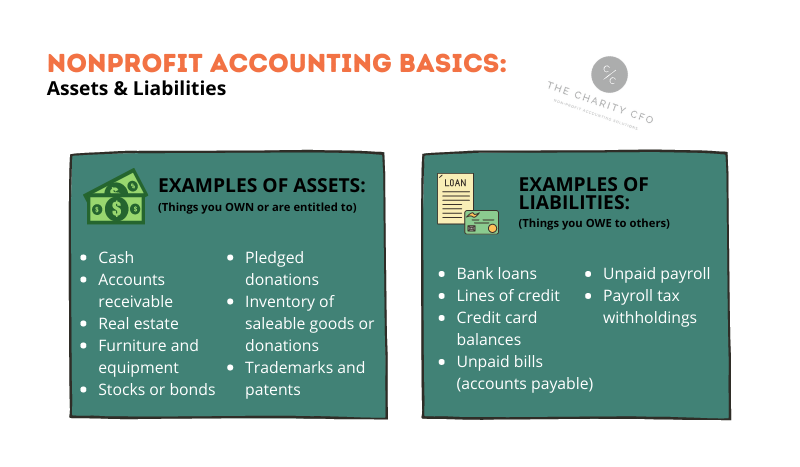If you’re like most nonprofit leaders, you’re not researching nonprofit accounting basics to satisfy your curiosity.
It’s a necessity.
You need to get a better grasp of your organization’s finances now. So you can understand what’s happening in your business and communicate effectively with your board members, donors, and financial team.
Well, you’ve come to the right place!
Start right here (👇) with this overview of nonprofit accounting basics.
Read through each section for a quick overview. And then, click on the links to dive deeper into the ones you need to master.
What is nonprofit accounting?
Investopedia defines accounting as “the process of recording financial transactions pertaining to a business.”
That’s really all that accounting is, so don’t let the terminology intimidate you.
You can grasp nonprofit accounting basics in just a few minutes, even if you’ve never taken an accounting course (and even if you hated math in high school).
Accounting rules exist to help you record transactions accurately and consistently over time.
And then, there are a series of reports and financial statements you’ll use to communicate the financial reality of your organization to potential donors, the IRS, watchdog agencies, and other stakeholders.
The basic accounting principles for nonprofit organizations are the same as accounting for for-profit companies.
So let’s start with the basics, and later we’ll dig into some of the things that make nonprofit accounting unique.
The simple equation behind nonprofit accounting:
Behind all the fancy formulas and financial statements, accounting exists to answer one question: how much financial value, or wealth, has your organization created?
And you can answer that question with a simple equation that looks like this:
(Assets) – (Liabilities) = (Net Assets)
Now before you run away, hold up!
Let’s break that down into simpler language:
(Everything you own) – (Everything you owe) = (The wealth you’ve created)
That wasn’t so bad, right?
And guess what? Your core financial reports, which we’ll look at below, exist to answer this one simple question– how much value has your organization created?

Do You Struggle to Make Sense of Your Financial Statements?
Get our FREE GUIDE to nonprofit financial reports, featuring illustrations, annotations, and insights to help you better understand your organization's finances.
Get the free guide!
The concepts in nonprofit accounting basics:
To understand nonprofit accounting basics, you’ll need to grasp some simple accounting terminology. Let’s start by defining the 3 terms we used above and giving you some examples of each. Then we’ll move onto some other common accounting terms:
Assets
Assets are anything that your nonprofit organization owns or is entitled to. So the cash in your bank account is an asset. But so are physical property, real estate, and computers. And money that was pledged to you but you haven’t received yet. Plus, even intellectual property– like patents or trademarks– may have value in certain cases.
Examples of nonprofit assets:
- Cash
- Accounts receivable
- Real estate
- Furniture and equipment
- Pledged donations
- Stocks or bonds
- Inventory of saleable goods or donations
- Trademarks and patents
Liabilities
Your liabilities are anything that your organization owes to anyone else. Obvious examples are loans or lines of credit. But it also includes accounts payable (unpaid bills), credit card bills, outstanding payroll, and more.
Examples of nonprofit liabilities:
- Bank loans
- Lines of credit
- Credit card balances
- Unpaid bills (accounts payable)
- Unpaid payroll
- Payroll tax withholdings
Net Assets
Your Net Assets are the accumulation of all the surpluses and deficits you’ve created since you’ve been in operation.
In other words, it’s the wealth or value that you’ve accumulated over time.
And it’s the core metric that outside observers will use to measure your organization’s financial value (and viability).
Revenue
Revenue is inflows that increase economic wealth. Frequently, this is cash from donations, grants, or fundraising activities. However, it can also be cash from sales of products, courses, or subscriptions. And it may also include non-cash donations (or in-kind donations) of goods or services.
Examples of nonprofit revenue sources:
- Cash donations
- Grant funds
- Sales of products or services
- Donations of goods (food, clothing, supplies)
- Donations of services (free rent, legal services, accounting, nonprofit discounts)
Expenses
Expenses are outflows of cash that decrease economic wealth. They include anything you pay for, from rent to payroll to purchasing supplies. Plus, non-cash outflows, like when you use or give away, resources you received as a donation.
Examples of nonprofit expenses:
- Rent
- Utilities
- Payroll
- Marketing
- Office supplies
- Program supplies
- Distribution or use of donated goods
Accounts Payable
Accounts payable is an account containing any outstanding bills or invoices that you haven’t yet paid. It shows as a liability on your financial reports, so it reduces your net assets.
Accounts Receivable
Accounts receivable is an account containing any revenue that you’ve earned, or that was committed to you, that you haven’t yet received. For a nonprofit, this often includes donations or grants that have been promised but won’t be delivered until a future date.
Accrual Accounting vs. Cash Accounting for Nonprofits
There are 2 main accounting systems that US businesses can use: cash basis or accrual basis accounting. There are distinct advantages to each, but first, let’s take a look at what each one is:
Cash-Basis Accounting
In a cash accounting system, you record transactions only when cash changes hands.
So, if you pay your electric bill in January, the expense is recorded in January even though you used the electricity in December. Similarly, if you receive a $100 donation in January, you’ll record it in January. Even if it was pledged to you last November.
Because this method of accounting tracks directly with money going into or out of your bank account, it’s by far the simplest method of accounting. And it’s preferred by many small nonprofits without experience in bookkeeping or the budget to hire a full-time accountant or outsourced accounting service.
Accrual-Basis Accounting
An accrual accounting system records transactions in the period where they are earned, pledged, or incurred. As a result, it matches your revenue with related expenses in the same period to give you a clearer picture of when you’re making or losing money.
Revisiting the above examples, you would book your electric expense to December in an accrual accounting system because that’s when you used the electricity (regardless of when you paid for it).
And you would record the $100 donation in November (when it was pledged), rather than January (when it was received).
An accrual is simply a manual adjustment to your books made without an exchange of cash. Accrual-basis accounting requires extensive use of both accounts payable and accounts receivable to keep track of these accruals.
How it works in real-life:
Let’s say you host a fundraiser in September that generates a significant number of donations. But you don’t pay your vendors until October and November.
Under cash accounting, you would show the revenue in September and the expenses in October. You would show a large “gain” in September and large “losses” in October and November. So it’s hard to tell how successful the event was.
Under an accrual system, both the event revenue and the expenses are booked to October, giving you a clearer picture of how much money generated by the event.
Accrual vs. Cash: Which is better?
Both cash and accrual accounting systems have their advantages for different types of organizations.
Cash accounting is much simpler and cheaper to maintain. It’s easier for simple tax filings and less susceptible to financial misconduct. Cash accounting may be a good choice for some small nonprofits with funding challenges.
Accrual accounting is required by Generally Accepted Accounting Principles (GAAP), which means that you’ll need accrual-based reports to complete a nonprofit audit. It also more accurately captures your ‘economic reality’ and helps you predict your finances better. Accrual accounting is the preferred method for any organization that needs to be audited or anticipates significant growth.
If you’re not sure which is right for you, read our in-depth article on how to choose cash accounting or accrual accounting for your organization.
How is nonprofit accounting different?
The core principles of nonprofit accounting are the same as for-profit accounting. However, there are a few significant differences that you need to know.
Difference #1: Terminology
While accounting principles are the same for both types of organizations, they don’t always speak the same language. Nonprofit accounting has its own terminology. Here are the key terms you’ll need to know
Net Assets – This term is used in 2 different ways.
- When it’s on the Statement of Activities (or Income Statement) it represents the net revenue for the period, what a for-profit business calls NET PROFIT.
- When shown on the Statement of Financial Position (or Balance Sheet), it represents the wealth you’ve created over time, or what for-profit business calls EQUITY.
Statement of Financial Position – This key financial statement (which we’ll discuss below) is called the BALANCE SHEET in a for-profit business. Some nonprofits will use the for-profit terminology to keep things simple, but the official nonprofit name for this report is the Statement of Financial Position.
Statement of Activities – Like the report above, this core financial statement has a different name than its for-profit version– the INCOME STATEMENT, or PROFIT AND LOSS (P&L) STATEMENT.
Difference #2: Fund Accounting
Most for-profit companies can use their revenue however they choose.
But nonprofits often have revenue that is restricted for certain reasons–the funds may be reserved for a certain program, be required to be spent at a certain time, or have other unique requirements for its usage.
To help track and manage these restrictions, nonprofits and governments use a system called fund accounting. It’s distinguished by its focus on accountability over profitability.
Fund accounting lets nonprofits set up individual “funds” to manage their revenue streams based on criteria like donor, grantor, timing, designated purpose, and restrictions for how, when, where, and/or why it is to be used.
Each fund can have its own revenue and expense report, accounting equation, and balance sheet. Or each fund may have its own line within revenue, expenses, assets and liabilities.
This allows you to see which funds are available for general use, and which are restricted for specific purposes. Check out this article to learn more about fund accounting.
Difference #3: Functional Expenses
Both GAAP and the IRS require nonprofits to report their expenses broken down into 3 categories:
- Program services expenses
- Management and general expenses
- Fundraising expenses
Because some expenses– like rent and payroll, for example– may fall into multiple categories, you’ll need to allocate your expenses according to how much they contribute to each function,
Difference #4: Revenue Recognition
GAAP requires that all pledges to donate are recorded when the pledge is made, not when the donation is received.
The general idea of accrual accounting is to match revenues and expenses in the same period. But this rule for nonprofit revenue recognition can throw a wrench into the works and lead to some big “gains” or “losses” on your financial statements.
We dig into this scenario in more detail in this article on the differences between nonprofit and for-profit accounting.
Nonprofit Accounting Basics: Financial Reports
Nonprofit accounting systems and best practices are established to keep you accountable to the public, your board, funders, grantors, and the government. And your nonprofit’s financial statements are the proof of that accountability.
Here’ we’ll overview the financial reports all nonprofit organizations are required to create regularly, as well as some optional reports that may help you run your business more effectively.
For an in-depth look at these reports, check out our article on the core nonprofit financial statements. Or click on any of the individual reports for a detailed breakdown of that report.
The 3 Core Financial Statements
These financial statements are required for a nonprofit audit. But, more importantly, they are often generated monthly (or quarterly) to help you keep an eye on your financial health.
1. Statement of Financial Position (or Balance Sheet)
The Statement of Financial Position the nonprofit version of a balance sheet. It summarizes your assets, liabilities, and restricted funds and gives a snapshot of what your organization owns and what it owes to others at a specific point in time
2. Statement of Activities (or Income Statement)
This report summarizes your revenue and expenses as net surplus or loss. It shows how much you’ve “earned” or “lost” during a specific period.
3. Statement of Cash Flows
The Statement of Cash flows shows how cash has increased or decreased across 3 segments of your business: operations, financing, and investing. This report can help you and your board members quickly understand which areas of your operation created or consumed cash over a period of time.
Other Common Nonprofit Financial Reports
Statement of Functional Expenses
This matrix-style report breaks down your functional expenses according to the natural and functional expense categories. It’s required for both an audit and your IRS 990 filing, but it’s often created on a quarterly or annual basis (rather than periodically, like the statements above).
Budget vs. Actual Report
Budget vs. Actual is an internal report which displays your planned budget and your actual performance side-by-side. So you and your team can easily see where you’re beating your plan or coming up short. It’s not required by GAAP or IRS, but it might be the single most useful report for nonprofit leaders on a day-to-day basis.
The Basics of Nonprofit Taxes
Thought you didn’t have to worry about taxes as a nonprofit? Think again!
For an in-depth look at taxes for nonprofits check out this article.
Tax Returns (IRS Form 990)
Nearly every nonprofit is required to file some form of the IRS 990 every year. If you fail to file a 990 for 3 consecutive years, your tax exempt status will automatically be revoked.
For some small nonprofits, the process is pretty easy. Others may want to reach out to an accountant for help.
To find out which 990 you need to file, check out this guide from the IRS.
Income Tax
Nonprofits are exempt from income tax on donations and much of their earned revenue. But if the IRS determines that revenue is from unrelated business activities (not directly related to your stated mission when requesting tax-exempt status), then it could be subject to income taxes. So check with your tax/legal team to make sure you’re prepared for any potential tax bills.
Payroll Tax
Nonprofit organizations must pay federal and local payroll taxes for their employees (and withhold payroll taxes on behalf of their employees, just like any other company.
Sales Tax
Rules for paying and collecting sales taxes are complex and vary from state to state. Check with your accountant and/or attorney to ensure compliance.
Other Taxes
Most nonprofits are exempt from property taxes and capital gains taxes from investments. Gains from real estate sales may be taxable income, depending on the circumstances.
Please consult a professional before making any decisions that may have tax implications. The tax code is complex and varies from state to state. It would be impossible to keep this article updated for all jurisdictions– so do your research and be prepared!
Going beyond the nonprofit accounting basics
The basic concepts of nonprofit accounting aren’t that hard to grasp.
But learning all the details and keeping up with your bookkeeping can be a big challenge for nonprofits of all shapes and sizes.
Working with an experienced nonprofit accounting firm could help you and your team focus your valuable time on growing your mission, rather than getting bogged down in your books.
At The Charity CFO, we work exclusively with nonprofit organizations and offer a start-to-finish solution for outsourcing your bookkeeping, financial statements, and expert advice.
Because nonprofit accounting is all we do, there is zero guesswork on terminology, procedures, and nonprofit-specific reporting like fund accounting and functional expenses.
If you want a professional team that understands your business and what you need, reach out to us today for a free consultation.

Do You Struggle to Make Sense of Your Financial Statements?
Get our FREE GUIDE to nonprofit financial reports, featuring illustrations, annotations, and insights to help you better understand your organization's finances.
Get the free guide!







Hello. My name is tim seldin and I am the president of the Montessori Foundation, 501(c)(3) and provides professional advice and services to the 5000-3 schools in North America. Proximately 65% of those schools are nonprofit. I enjoyed your blog post about nonprofit accounting. I wonder if you’d be interested in being a guest on one of our weekly webcasts 4 L of Montessori Schools. We also publish a magazine for Montessori Schook leaders called Montessori leadership. With minor modifications, turning your byline in the something that’s not quite so obvious as a direct sales pitch, I believe that it would make a nice short article. Let me know if you’re interested.
Tim, thank you for your response and interest! Please refer to your email inbox, and TCCFO will communicate with you directly.